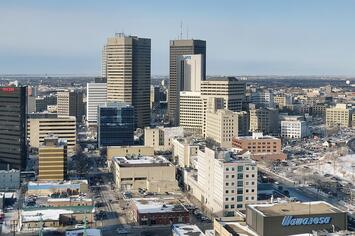
Canada’s housing affordability crisis is a matter of considerable concern especially for young people trying to buy a house. The worst problems are in the Vancouver and Toronto markets with their excessive land use regulation. Extensive international research associates stronger land use regulation with diminished housing affordability. Vancouver and Toronto are experiencing substantial net migration of people to other markets in BC and Ontario where housing tends to be less costly. But in markets that are subject to similar regulations, housing affordability is deteriorating.
This is illustrated in Demographia Housing Affordability in Canada, a report that was just released by The Frontier Centre for Public Policy which rates housing affordability in 46 Canadian markets (census metropolitan areas or CMAs). Vancouver has a median price to pretax household income ratio (“median multiple”) of 13.3, which has more than tripled over the past half-century. In Toronto, the median multiple is 10.5, a near tripling since 2000.
Vancouver and Toronto, are the third and tenth least affordable among the 92 markets in in eight nations: Australia, Canada, China, Ireland, New Zealand, Singapore, the United Kingdom and the United States) in an earlier Frontier report Demographia International Housing Affordability (published in March)). Other BC CMAs now rated severely unaffordable (median multiples of 5.1 or more) include Victoria, Nanaimo, Kelowna, the Fraser Valley, Kamloops, and Chilliwack. Nearby Toronto severely unaffordable markets include Hamilton, Oshawa, Cambridge, Peterborough, Kitchener-Waterloo, Barrie, Guelph, St.Catharines-Niagara, Brantford, and London. Farther away, Belleville and Kingston are also severely unaffordable.
During the pandemic, severely unaffordable housing has occurred in Montreal, Ottawa-Gatineau, Halifax, Charlottetown and Whitehorse.
But some markets are much more affordable, especially in the Prairies, Atlantic Canada, and Quebec, outside Montreal. Among the larger markets, the most affordable are Edmonton (3.6), Quebec (3.7), Winnipeg (4.0), and Calgary (4.0).
However, only three of the 46 Canadian markets are rated “affordable” (median multiples of 3.0 or less), Fort MacMurray, (2.1), Saguenay (2.8), and Moose Jaw, (3.0). More are rated “moderately unaffordable,” with median multiples of from 3.1 to 4.0: Cape Breton, Fredericton, Regina, Saskatoon, Medicine Hat, Trois Rivieres, Saint John, St. John’s, Thunder Bay, and Moncton.
There is increasing concern about inequality because housing affordability is the very heart of inequality. When house prices triple relative to incomes, homeowners in the escalating markets gain, while those in markets with less escalation lose ground. Younger households, even those who are already in anexpensive markets, face greater inequality. Finally, renters, without house equity, face the largest losses of all. The reality is that when house prices rise faster than incomes, inequality inevitably increases.
Governments are a principal source of this inequality, through their land use regulations associated with diminished housing affordability. A principal example is “urban containment” policy, which includes strategies like urban growth boundaries, greenbelts, and agricultural preserves. These policies are intended to stop urban expansion, and they have driven up land prices in remaining urban area where new houses can be built. Before the pandemic, all of the markets rated as severely unaffordable in Demographia International Housing Affordability were subject to urban containment regulations.
The higher land values from urban containment policies are the principal problem. House construction costs do not vary substantially across the nation. For example, the costs per square foot to build the average detached house in the Vancouver or Toronto markets no more than 30% higher than in Winnipeg. Yet, the higher land values push the average detached house prices to 340% higher in Vancouver and 225% higher in Toronto compared to Winnipeg.
Moreover, these prohibitive land costs are principally beyond the control of any of the municipalities in larger markets, such as Vancouver, Toronto, and Montreal. The substantially elevated land values at the urban periphery and throughout the urban area are largely driven by provincial laws and policies.
Where housing has become severely unaffordable, especially in British Columbia, Ontario, and the Montreal CMA, policies should be restructured to reduce peripheral land values so that house prices generally rise no faster than incomes.
Perhaps the greatest imperative is to preserve the affordability that already exists in markets where housing affordability has not deteriorated, These markets would include CMAs such as Edmonton, Regina, Winnipeg, Quebec, Moncton, and a number of other markets where a modicum of affordability has been retained.
This piece first appeared at Frontier Centre for Public Policy.
Wendell Cox is principal of Demographia, an international public policy firm located in the St. Louis metropolitan area. He is a founding senior fellow at the Urban Reform Institute, Houston, a Senior Fellow with the Frontier Centre for Public Policy in Winnipeg and a member of the Advisory Board of the Center for Demographics and Policy at Chapman University in Orange, California. He has served as a visiting professor at the Conservatoire National des Arts et Metiers in Paris. His principal interests are economics, poverty alleviation, demographics, urban policy and transport. He is co-author of the annual Demographia International Housing Affordability Survey and author of Demographia World Urban Areas.
Mayor Tom Bradley appointed him to three terms on the Los Angeles County Transportation Commission (1977-1985) and Speaker of the House Newt Gingrich appointed him to the Amtrak Reform Council, to complete the unexpired term of New Jersey Governor Christine Todd Whitman (1999-2002). He is author of War on the Dream: How Anti-Sprawl Policy Threatens the Quality of Life and Toward More Prosperous Cities: A Framing Essay on Urban Areas, Transport, Planning and the Dimensions of Sustainability.
Photo: Winnipeg, by Bob Linsdell via Wikimedia under CC 3.0 License.












